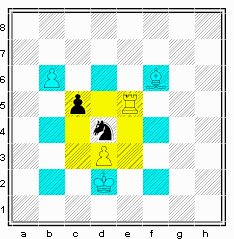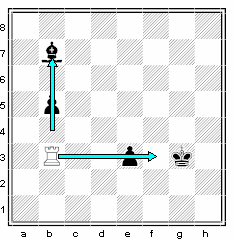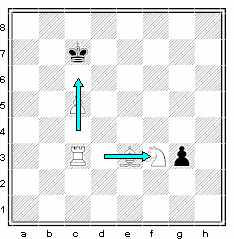Asylum Chess
The game Asylum Chess and its theme were conceived by Charles Daniel in 2007.Asylum Chess is a 10*10 board variant of chess played with the same rules as standard chess but with three new unique pieces that change the tactics and strategy of the game considerably :
- The Insane Ninja Knight - The knight has attained the ninja powers which include new short range leaps and a dangerous double capture ability. Its excellent short range ability introduces new tactical complexities to the game.
- The Mad Leaping Bishop - This bishop combines a long leaping move with its original power.
- The Super Loony Rook - Two powerful rooks with enhanced powers that include fire-through and double capture capabilities replace the original two rooks.
Setup
Pieces
Pieces and movement
Insane Ninja Knight
 |
Moveset 1: The knight moves and captures like a knight exactly as in standard chess capturing once only on the landing square.
(uncolored squares c2,e2,f3,f5,e6,c6,b5,b3).
Moveset 2: The ninja can move like a non-royal king: orthagonally (sideways, up or down) and diagonally 1 step. Moving and capturing on landing square. (yellow colored squares all controlled by black knight) Moveset 3: The ninja can leap two squares orthagonally (sideways, up or down) and diagonally, capturing the enemy piece on the landing square. It jumps over a friendly piece. (all blue squares are controlled by black knight) |
Moveset 4
If in case above (moveset 3), there is an enemy piece in the way, the ninja captures the piece that it jumps over.
The ninja can capture two pieces in this manner. Leaping over an enemy piece, and capturing an enemy piece when it lands.
In the diagram, the black insane ninja knight can capture rook on e5 and bishop on f6.
The easy way to see this is that if two enemy pieces are in the same line (orthogonally or diagonally), the insane ninja knight can capture both of them with its short 2 square leap.
In diagram, the insane ninja knight is threatening all of white's pieces simultaneously including giving check to the white king.
Mad Leaping Bishop
This piece moves just like a regular bishop except that it has the additional leaping moves as shown. : |
It can leap over friendly/enemy pieces when performing the leaping move. It only captures once on the square it lands. If moving like a bishop it cannot leap. The leaping move is 3 steps orthoganally and 1 step perpendicular (3,1) as opposed to the knight move (2,1). Bishops in Asylum Chess move exactly as in normal chess. The bishop shown in diagram is a Mad Leaping Bishop not a regular bishop. |
The Super Loony Rook:
There are two variants of the rook move that can be invoked in a game: Normal and friendly fire. The friendly fire variant adds another intriguing tactical possiblity to the rook move, but it is only an optional rule and need not be invoked.Normal (standard) Move
The Super Loony Rook can be described as a double power rook meaning that it has the power to fire through an enemy piece, cutting down 2 pieces with one blow. The loony rook also can capture one enemy piece like a normal rook or land on an empty square on the same line beyond the enemy piece. The key point is that it fires through the enemy piece.
 |
Say the Super Loony Rook is at b3 (see diagram) and an enemy piece on b5 and b7. This powerful rook can capture pawn on b5 like a normal rook, or fire through the pawn on b5, and land on empty square b6 if desired, or capture (for 2nd time) at b7.
Note that the rook is threatening all the pieces shown, pinning the pawn at e3 and giving check at g3, so it is Black's turn to play. The black king must move to get out of the check or the bishop can interpose at f3. If black interposes with bishop (rook cannot fire through more than 2 pieces), white can capture the pawn at e3 and give check through the bishop! Note that in this case, it can also capture both pawn at e3 and interposing bishop giving check, but then the king can capture the rook. Alternatively, if black moves the king, then the rook can capture both pieces on b5 and b7, so the Bishop move to f3 seems best. |
Friendly Fire Variant
 |
The friendly fire variant is even more intriguing (though its effect has not being studied). It is advisable to play this variant only
after considerable practice playing Asylum chess using the normal move of the super loony rook (described above). The rook moves as described above but now it can also fire through its own piece (sacrificing it, not jumping over it) to reach an opponent. In the diagram, the rook is giving check through its own piece! Note that white has NOT fired through the pawn yet, but is threatening to do so, hence the check. The black king must move to get out of check. It is possible to fire though one's own piece to reach an empty square, but that would be rare in practical use. Also, a rook can fire through 2 of its own pieces, perhaps to force stalemate for example. In the diagram, after the black king moves, the rook can fire through its own pieces to get to f3. However, this does not seem practical. |
 |
IN this diagram, black has just promoted his pawn, but the white rook can capture the black queen by firing through the white bishop (sacrificing it). However, the white rook after capturing the black queen CANNOT give check to the black king because it has to fire through its own king to do so. |
To summarize the moves:
- Movement exactly like a rook
- Can capture exactly as a rook.
- Can capture by firing through enemy piece and landing on empty square on same line.
- Can capture by firing though enemy piece 1 and landing and decimating enemy piece 2 that lies on the same line.
The Mad Queen
This is the same mad queen in standard chess and so has the same moves.The Bishop
Moves exactly as in standard chess.King
Same as in standard chess.Rules
The rules in Asylum Inmate Chess are the same as in chess except for the following modifications and using the new pieces:- Castling is done by moving the king three squares to the left or right and moving the rook next to it. For example, white can castle kingside (providing no other pieces are in between, and no squares over which the king travels are attacked) by moving his king from f1 to i1 and his rook from j1 to h1. On the queenside, white king moves from f1 to c1 and rook from a1 to d1.
- Pawn moves: The pawn can move from its original position either 1, 2 or 3 squares forward. Subsequently as in normal chess, it can only move 1 square forward. If a pawn moves 1 square forward from its original position, it loses its ability to move more than 1 square forward and can only move forward 1 square at a time.
- En Passant: If a Pawn moves two or three squares initially and passes an opposing Pawn on the fourth or fifth rank, the Pawn may be captured en passant. E.g. White pawn on a2 black pawn on b4. If the white pawn moves from a2 to a4 or a5, the black pawn on b4 can capture it as if it had moved to a3. Similarly, if the black pawn is on b5 instead and the white pawn moves to a5 from a2 then the black pawn can capture the white pawn as if it moved to a4. Note in this case the white pawn can still avoid the black pawn by moving to a3 instead.
Capturing en passant is optional unless it is the only legal move available. The capture must be made on the next move. - Pawn promotion: Pawns can now promote to: mad queen, mad-bishop, bishop, insane knight, or loony rook on the 10th rank only.
- Illegal Moves:
- If using the friendly fire rule the enemy king cannot stand in line of fire from rook even if the rook is behind a friendly piece unless the friendly piece that blocks the rook is a king in which case the friendly fire rule is temporarily out of action.
- An enemy king cannot be in the line of fire of an rook even if there is a enemy piece in between regardless of which variant is used. This is obvious since the rook can give check through that one piece. (see loony rook move info)
- Obviously, you cannot interpose a piece if the rook directly checks a king in both variations.
Notes
- The insane ninja knight alone can deliver mate, and if deployed safely in the center, can control up to 24 squares around it! So in many situations it is at least the second most powerful piece.
- Bishops, though now the weakest pieces on the board, can be used to harass the more powerful pieces. The fact that 4 bishops (2 bishops and 2 leaping bishops) can be used in conjunction is important to consider.
- A half open file is very dangerous because the rook can simply fire through the pawn to the back rank.
Early Mates
The following are some opening debacles leading to early checkmate:| Contrived, but good for demonstration purposes |
More info on the new pieces
Because of the maddening variety of pieces that existed throughout chess history, the author would like to clear up any confusion as to what pieces and their abilities are original, and what has been derived from older pieces.
Super Loony Rook
This piece is derived from the rook, and bears a slight similarity to the Canon used in Chinese Chess. Rook/Cannon combos have been tried in other variants, but the firing-through and double-capturing ability of this piece sets it apart. The author has not seen any other chess variant with an identical piece, so unless proven otherwise, the reader can assume this is an original creation of the game inventor.Insane Ninja Knight
The moves of this piece are a superset of compounds pieces such as the centaur or the FAD. The movement of the Insane Ninja Knight is equivalent to the Knight + Ferz + Wazir + Dabbabah + Alfil. However, none of the above have the unique double capturing and jump-over capturing ability of the insane ninja knight. The lion used in Cho Shogi lion encompasses every move of the insane ninja knight but the rules governing its movement are far more complex. Nonetheless, this seldom seen piece does resemble the very unique Insane Ninja Knight.Mad Leaping Bishop
This piece is essentially the same as the Caliph or the Flying Dragon. It is a combination of the moves of the bishop and the camel. Only the name is an original creation; the piece and its movement already existed.Background Story
One warm sunny day, the author got lost in the woods. After numerous attempts at finding his way, he stumbled upon a dilapidated building with an unkempt yard. In the middle, two strange looking fellows were playing chess. One fellow let out a scream, and banged his rook upon the board. The other player began to cry. He had apparently lost the game. The player who screamed then captured two of his opponent's pieces (in one move!) picked them up and flung them at the crying player. The author was shocked, not just at the strange behavior of these odd looking men, but of the fact that the two were not playing normal chess, but some strange variant of it.
As some burly guys dressed in white took the loser away, the author asked the winner to explain the rules of this strange new game.
The winner complied, and described it in vivid detail, albeit with many bizarre explanations.
For example, he described the knight's new moves as follows: "The insane ninja knight jumps over the enemy piece, kicking and decapitating it, before finishing its jump and dealing another deathblow to the second enemy piece."
Or he described stalemate as follows: "The objective is to kill the opponent's king by cutting off his head, and using it as a trophy. If the enemy king takes his own life by setting himself on fire, his head cannot be used as a trophy, so it is a draw."
The stalemate rule is actually the same as in normal chess, except that the inmates enjoy this more picturesque version of the rules.
Stranger still, he confided in the author that he was a former chess Grandmaster, and that he would surely become the world champion if this were the game of choice. After concluding his pleasant conversation, the author got back home to transcribe the rules.
He returned the next day, realizing he had forgotten to ask the grandmaster for his name. Unfortunately, he found nothing but an abandoned building with an iron gate. Not a soul was in sight, except for a rusty iron gate with the words 'ASYLUM' inscribed in the metal. The rest of the inscription was illegible.
So with a heavy heart, the author has taken responsibility as the inventor of this game. If however, the grandmaster returns and claims his invention, the author would gladly oblige. For now the world must wait until Asylum Chess becomes popular enough for the forgotten Grandmaster to leave the asylum and challenge the current world champion.
 This 'user submitted' page is a collaboration between the posting user and the Chess Variant Pages. Registered contributors to the Chess Variant Pages have the ability to post their own works, subject to review and editing by the Chess Variant Pages Editorial Staff.
This 'user submitted' page is a collaboration between the posting user and the Chess Variant Pages. Registered contributors to the Chess Variant Pages have the ability to post their own works, subject to review and editing by the Chess Variant Pages Editorial Staff.
By Charles Daniel.
Last revised by Fergus Duniho.
Web page created: 2007-08-21. Web page last updated: 2022-11-25